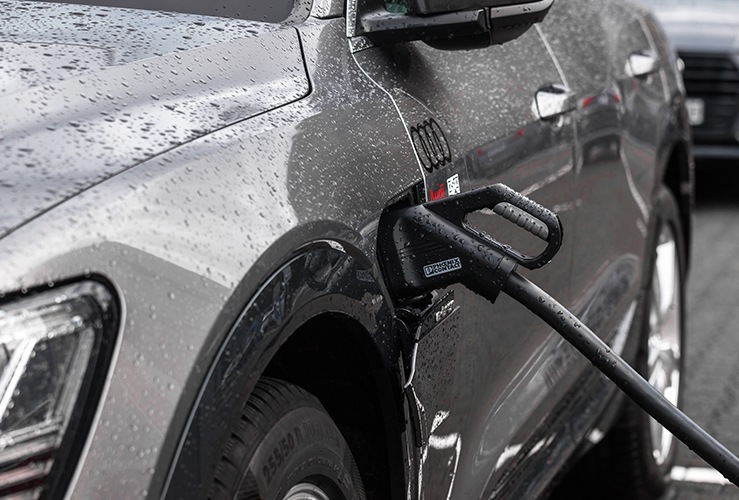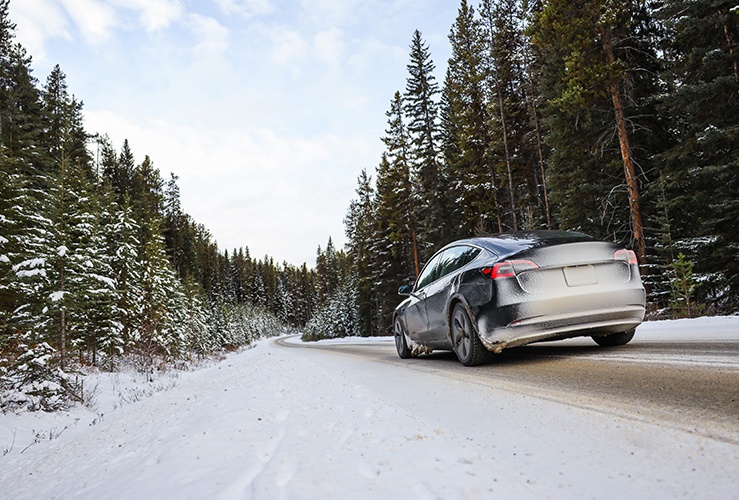Temperature, rain and wind can all have an impact on how far your EV will go on a single charge. In this article we'll explore exactly how these forces increase or decrease your vehicle's battery efficiency - and in the case of icy conditions, how handling can be affected.
EV range: Cold, mild and hot conditions.
How far an EV can go on a single charge is a key consideration for any would-be buyer. But how does weather - or more specifically, temperature - affect range?
According to an analysis by Consumer Reports in the United States, temperature can have a dramatic effect on range.
For example, they analysed the Ford Mustang Mach-E Extended Range model, which has an Official EPA range of 270 miles.
However, in cold temperatures the study found the range dropped to just 188 miles.
In mild temperatures, the range was 250 miles.
But in summer, the range slightly exceeded the official figures - at 275 miles.
Consumer Reports also tested the Tesla Model Y (EPA range 326), with similar results: Cold: 186 miles; Mild: 252 miles; and Hot weather: 274 miles. Interestingly, the Model Y never reached the Official EPA range under any of the tested conditions.
Other factors impacting range
It should be noted that an EV's range can be affected by several other factors - including hills, cargo, passengers, aerodynamics, speed and traffic levels.
Heat ages lithium-ion batteries more quickly
While there may be some range advantages to driving in hot weather, heat can increase the rate of chemical reactions in the cell, making it age more quickly.
So, while driving in winter may reduce your range - at least in the above examples - it could see your battery age more slowly. For those who live in colder climates, they may find their batteries last longer than cars used in warmer climates.
Air conditioning and EV battery efficiency
While in controlled testing environments EV range may be extended in hot weather, this may not be the case if your air conditioning system is seeing heavy use. Air-con systems can be a significant drain on your battery, reducing any advantage of hot-weather motoring.
However, in one test conducted by Wrecking Fool on YouTube, a Chevrolet Volt actually performed slightly better in higher temperatures - even with the air conditioning being used.
The combustion engine's winter advantage
In low temperatures, internal combustion engine cars have a slight advantage over electric vehicles. The heat generated by petrol or diesel actually warms the car via the fans - meaning air conditioning may not be required. Conversely, EVs don’t produce heat so quickly, and it cannot be harnessed in the same way - so the AC must be turned on (which draws extra current from the battery).
Battery management systems
Most EVs feature battery management systems. This monitors the temperature, charge and use of high voltage batteries. They prevent high voltage charging if your battery is too warm, and may use liquid coolant systems in your car to manage the temperature.
While you shouldn’t worry about using your EV in warmer temperatures, acting to cool your battery down will improve battery life in the long term.
Driving EVs in winter
When a lithium-ion battery is cold, damage can occur if the battery is charged at a high rate. However, this should be prevented by the battery management system.
Teslas, for example, will preheat the battery in low temperatures, so it can be charged at the full charging rate (known as 'fast charging'). This process uses a little more energy, but can save time when charging.
The good news is that while EVs charge slower in cold temperatures, battery life may be improved.
Regenerative braking in cold temperatures
Many EVs have regenerative braking, which harnesses braking energy to recharge the battery. However, in cold temperatures regenerative braking may not work. In extremely low temperatures the car’s output may be reduced by the battery management system, and some of the battery’s capacity may be temporarily locked off.
Once the battery warms up, the above restrictions will be lifted.
If a battery has been in freezing conditions for several hours, it may not begin charging straight away. Instead, it may use current to warm the battery, so that charging can start.
Manufacturers warn against exposing EVs to extremely low temperatures (below -30 Celsius) - although this will never be a problem for UK EV owners!
Using an EV’s heated seats in cold temperatures
While using the air conditioning system will draw a significant amount of current from the EV's battery, heated seats only use a negligible amount. You can reduce battery drain by using the heated seats instead of the car's heating system.
If you do use the EV's heating system, the good news is that it will provide almost instant heat - which can’t be said of combustion-engine cars.
How do icy conditions affect EV range?
Electric cars are typically front-wheel-drive, which gives them better traction in snowy or icy conditions. EVs also have a lower centre of gravity, due to the low position of the battery pack - which improves stability in icy or snowy conditions.
How does rain affect EV efficiency?
Some parts of the UK experience high annual rainfall, so it’s important to understand how rain affects efficiency. In short, wet roads increase rolling resistance, which means the EV battery will experience higher drain.
The YouTube channel Daily Motor tested a Volvo XC40, and found the battery experienced 10% more drain on wet roads compared to dry roads.
How does wind affect EV range?
As you might expect, driving with the wind facing you will increase air resistance and therefore increase drain on your battery. However, if you have a significant tailwind, battery efficiency may see a slight improvement. This is discussed in more detail on MotorMatchup (YouTube).
In conclusion
Weather can impact an EV's efficiency in various ways - some positive, some negative. However the same can be said of combustion engine cars.






